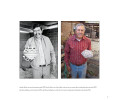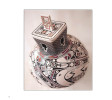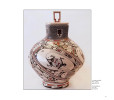PUBLICATIONS: VOLUME I: Graciela & Hector Gallegos
THIS IS THE STORY of internationally recognized ceramicists Graciela Martinez and Hector Gallegos beginning with the arrival of their grandparents from China and California to the remote village of Mata Ortiz in the Mexican state of Chihuahua in the early part of the 1900's up to the present. This volume recounts moments in the Industrial and Mexican Revolution, the Agrarian Reform Movement in Mexico and the formation of a lucrative pottery tradition in the village. The story is based on oral histories of the participants and contains over 120 photographs. The text is in both English and Spanish.
The Collector’s Edition is a large format 13 x 11 book with an image-wrap hard cover. The 80- page book has over 120 photos beautifully printed on premium quality photo paper. If you collect Mata Ortiz pottery this is the edition you will want to have. The book is also available in a less expensive 10 x 8 soft cover.
































